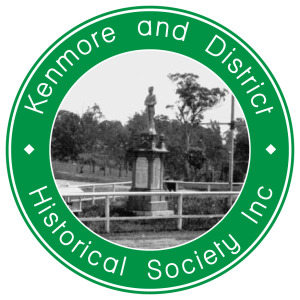Research Policies and Procedures
Objectives
In order to meet the object in the constitution of studying and promoting the history of the Kenmore District, the Society aims:
- to collect and preserve oral and written records, images, films, maps and electronic records representing the history of the Kenmore District from its foundation to the present.
- to seek to ensure that material collected for research purposes covers a broad range of themes – for example, domestic life, education, people, recreation and social life, local industry and commerce, religion, working life, services, transport, built environment
- To disseminate that research
Types of Research Material
The physical items to be collected for the research collection include:
- Primary sources including diaries, minute books, correspondence, documents, archival maps, ephemera etc
- Secondary sources including books, newspaper articles, event programs, community newsletters, maps and street directories, telephone books and computer generated information
- Written memoirs
- Photographs including school photographs, family photographs, promotional photographs (e.g. real estate brochures, commercial promotions) and aerial photographs of the district
- Audio and video recordings
Collection Guidelines
- Items for the research collection can be copied, donated or purchased.
- The Management Committee has to approve the purchase of any items.
- Items must relate to or be significant for the Kenmore District or to a person who once lived in the district. The only exception is books that provide background history or context of a broader area.
- Every item must have an acquisition form completed (attached)
- The Society aims to achieve high standards of collection, care and storage. Every effort will be made to use archival quality storage materials, particularly for photographs
- Items should only be repaired, where applicable, using archival materials
- Collection should be coordinated by the Management Committee, which reserves the right to decline inappropriate material or badly damaged items.
- Original items will not generally be loaned for third party display. The cost of copies, particularly photographs, should be met by the person or organisation seeking the loan. The loans form must be completed for this activity.
Points to be considered when collecting
- Space and storage facilities
- Available funds (or grants) for correct storage
- Access facilities, both electronic and physical
- Duplication of material if a number of people are collecting
- Insurance costs
Deaccession and Disposal Procedure
- This matter can either be dealt with by the Management Committee or a special sub-committee. The key requirement is that deaccession should be subject of a committee’s recorded decision.
- Deaccession can occur under the following circumstances:
- An item proves to be of wider or greater significance than initially known, and such an item may be better conserved if transferred, by agreement, to another institution such as the Queensland Museum, State Library or RQHS.
- An item that has more relevant significance to a society with similar aims in another district. Such an item can also be transferred by agreement.
- There are multiple copies of an item, and there may be good publicity value for one of the items to be given to an appropriate person who will display the item in a public place.
- An item that is in very bad condition so as to render it of no research value can be disposed of.
- An item may have paper-based insect activity that can not easily be fumigated and therefore has the potential to harm other paper-based material in close storage proximity. The item can be disposed of.
- Any deaccession or disposal action must be fully documented.
Review
The Management Committee will review the Research Collection Policy and Procedures at each planning day.


